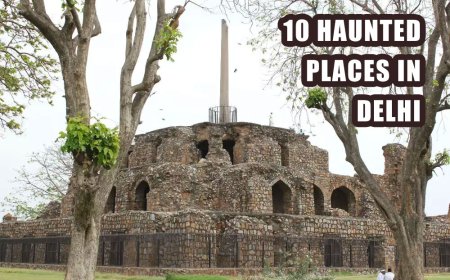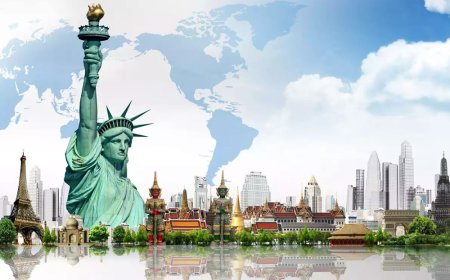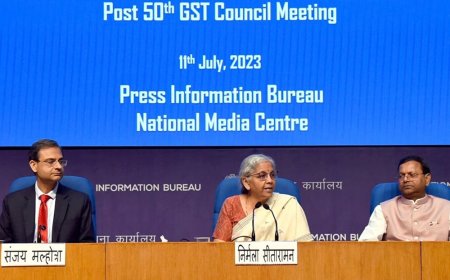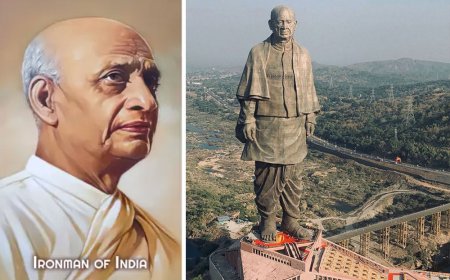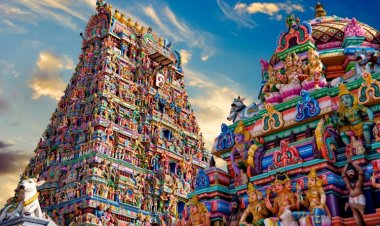All You Need To Know World Heritage Day 2023
World Heritage Day, also known as International Day for Monuments and Sites, is marked on April 18 each year to promote awareness of the value of preserving cultural heritage and to honor the variety of the world's cultural legacy. The International Council on Monuments and Sites (ICOMOS) first suggested the idea for World Heritage Day in 1982, and the UN General Assembly later accepted it in 1983. The date, April 18, was chosen to mark the occasion of UNESCO's 1982 adoption of the Convention Concerning the Protection of World Cultural and Natural Heritage.

The main goal of World Heritage Day is to increase public awareness of the need of safeguarding cultural assets, such as historic sites, monuments, and aging buildings. The purpose of the day is to inspire people to value the variety of the world's history and to become involved in its preservation and conservation.
For World Heritage Day, a subject is decided upon each year to highlight a particular facet of cultural heritage. The themes for 2022 and 2023 are "Heritage Changes" and "Heritage and Climate", respectively.
Celebrations of World Heritage Day usually involve a wide range of activities, such as exhibits, social gatherings, and guided tours of historic sites. These initiatives seek to increase knowledge of cultural heritage, its understanding and appreciation, and the dangers that these places face from things like climate change, natural catastrophes, and human activity.
History Of World Heritage Day
The International Day for Monuments and Sites, also known as World Heritage Day, is observed on April 18 each year to raise awareness of cultural heritage and to advocate the preservation and conservation of significant historical sites across the globe.
The idea for World Heritage Day was first proposed by ICOMOS (International Council on Monuments and Sites) in 1982, and UNESCO (United Nations Educational, Scientific and Cultural Organization) later approved it during the 22nd General Conference in 1983. April 18, 1982, saw the creation of the ICOMOS, hence that day was chosen to mark the occasion.
The World Heritage Day commemoration is centered around a distinct cultural heritage-related subject each year, such as sustainable tourism, cultural landscapes, or heritage in times of conflict. Events and activities planned by UNESCO, ICOMOS, as well as local communities and organizations throughout the world, commemorate the day.
World Heritage Day is to increase public awareness of the value of cultural heritage and to inspire people to become engaged in the preservation and protection of historical sites and monuments for the enjoyment of present and future generations.
Significance Of World Heritage Day
The purpose of World Heritage Day is to spread awareness of the value of conserving cultural heritage and the world's monuments and sites from degradation and destruction.
World Cultural Day was created in 1983 by the United Nations Educational, Scientific, and Cultural Organization (UNESCO) to promote awareness of the importance of cultural assets and the need to protect them for future generations. Additionally, the day offers a chance to encourage global collaboration in cultural heritage preservation and to recognize the diversity of civilizations throughout the world.
To promote awareness of the importance of historic places, their role in the construction of our history and identity, and the need for their preservation, a variety of events and activities are organized across the world on this day. Exhibitions, escorted tours, talks, seminars, and other cultural activities are among these occasions.
People may learn about the many natural and cultural heritage sites across the globe and appreciate the importance of their preservation by participating in Globe Heritage Day activities. Additionally, the day serves as a reminder that heritage sites are important not just for their cultural and historical value but also for their effects on local economies, tourism, and sustainable development.
Importance Of World Heritage Day
The need of preserving these landmarks for future generations is underscored by World Heritage Day, which serves as a reminder of the tremendous cultural and historical worth they have. It also emphasizes the important part heritage sites play in encouraging cultural understanding, increasing tourism, and growing the economy.
World Heritage Day encourages people to respect and learn from many cultural viewpoints by celebrating the diversity of cultures and traditions that make up our global heritage. It encourages worldwide collaboration and cooperation to protect these locations as well as the necessity of sustainable development that honors each location's unique natural and cultural history.
People also exchange greetings on this day to express their gratitude for the cultural sites, monuments, and landmarks that highlight every facet of our planet and our common human past. We recognize the importance of these places and the need to preserve them for future generations by hoping for their preservation.
What Do You Understand by Heritage Sites?
Heritage sites are places or landmarks that are highly significant to a particular community, society, or country in terms of their cultural, historical, scientific, or artistic value. The structures, monuments, landscape elements, or other locations that have been chosen for preservation because of their significance in defining a region's natural or cultural identity may be included in this list.
"National or international legislation frequently protects heritage sites to ensure their preservation and to raise awareness and appreciation of their worth. The World Heritage List, maintained by UNESCO, the United Nations Educational, Scientific, and Cultural Organization, honors places of great universal importance that should be preserved for future generations.”
Heritage site preservation may have a variety of advantages, such as encouraging national pride, increasing tourism, and conserving historical or cultural legacies. By safeguarding natural and cultural resources, heritage site protection may also support environmental conservation and sustainable development.
Natural catastrophes, environmental deterioration, excessive tourism, and armed conflict are all risks for cultural sites. Therefore, to preserve the long-term viability of these significant cultural and natural sites, it is crucial to strike a balance between the need for preservation and the requirement for sustainable use and management.
A list of Heritage sites in India declared by UNESCO
As of right now, 40 Indian Destinations have been designated as World Heritage Sites by UNESCO. The following is a list of India's World Heritage Sites, organized according to their categories:
UNESCO Cultural World Heritage Sites In India
|
S.No. |
Site |
Place |
Year of declaration |
|
1. |
Taj Mahal |
Uttar Pradesh |
1983 |
|
2. |
Ellora Caves |
Maharashtra |
1983 |
|
3. |
Ajanta Caves |
Maharashtra |
1983 |
|
4. |
Agra Fort |
Uttar Pradesh |
1983 |
|
5. |
Sun Temple, Konarak |
Orissa |
1984 |
|
6. |
Group of Monuments at Mahabalipuram |
Tamil Nadu |
1984 |
|
7. |
Khajuraho Group of Monuments |
Madhya Pradesh |
1986 |
|
8. |
Group of Monuments at Hampi |
Karnataka |
1986 |
|
9. |
Fatehpur Sikri |
Uttar Pradesh |
1986 |
|
10. |
Churches and Convents of Goa |
Goa |
1986 |
|
11. |
Group of Monuments at Pattadakal |
Karnataka |
1987 |
|
12. |
Great Living Chola Temples |
Tamil Nadu |
1987 |
|
13. |
Elephanta Caves |
Maharashtra |
1987 |
|
14. |
Buddhist Monuments at Sanchi |
Madhya Pradesh |
1989 |
|
15. |
Qutb Minar and its Monuments, Delhi |
Delhi |
1993 |
|
16. |
Humayun’s Tomb, Delhi |
Delhi |
1993 |
|
17. |
Mountain Railways of India |
Tamil Nadu |
1999 |
|
18. |
Mahabodhi Temple Complex at Bodh Gaya |
Bihar |
2002 |
|
19. |
Rock Shelters of Bhimbetka |
Madhya Pradesh |
2003 |
|
20. |
Chhatrapati Shivaji Terminus |
Maharashtra |
2004 |
|
21. |
Champaner-Pavagadh Archaeological Park |
Gujarat |
2004 |
|
22. |
Red Fort Complex |
Delhi |
2007 |
|
23. |
The Jantar Mantar |
Rajasthan |
2010 |
|
24. |
Hill Forts of Rajasthan |
Rajasthan |
2013 |
|
25. |
Rani-Ki-Van |
Gujarat |
2014 |
|
26. |
Archaeological Site of Nalanda Mahavihara (Nalanda University) |
Bihar |
2016 |
|
27. |
Jaipur City |
Rajasthan |
2020 |
|
28. |
Historic City of Ahmedabad |
Gujarat |
2017 |
|
29. |
Victorian and Art Deco Ensemble of Mumbai |
Maharashtra |
2018 |
|
30. |
The Architectural Work of Le Corbusier, an Outstanding Contribution to the Modern Movement |
Chandigarh |
2016 |
|
31. |
Kakatiya Rudreshwara (Ramappa) Temple |
Telangana |
2021 |
|
32. |
Dholavira |
Gujarat |
2021 |
UNESCO Natural World Heritage Sites:
|
S.No. |
Site |
State |
Year of declaration |
|
1. |
Kaziranga National Park |
Assam |
1985 |
|
2. |
Keoladeo Ghana National Park |
Rajasthan |
1985 |
|
3. |
Manas Wildlife Sanctuary |
Assam |
1985 |
|
4. |
Nanda Devi National Park and Valley of Flowers |
Uttarakhand |
1988, 2005 |
|
5. |
Sundarbans National Park |
West Bengal |
1987 |
|
6. |
Western Ghats |
Maharashtra, Goa, Karnataka, Tamil Nadu, and Kerala |
2012 |
|
7. |
Great Himalayan National Park |
Himachal Pradesh |
2014 |
UNESCO Mixed World Heritage Sites in India
|
S.No. |
Site |
State |
Year of declaration |
|
1. |
Khangchendzonga National Park |
Sikkim |
2016 |
World Heritage Day is a chance for people, groups, and governments to come together and work toward preserving cultural heritage assets for future generations by safeguarding and promoting them.
What's Your Reaction?
 Like
0
Like
0
 Dislike
0
Dislike
0
 Love
0
Love
0
 Funny
0
Funny
0
 Angry
0
Angry
0
 Sad
0
Sad
0
 Wow
0
Wow
0















